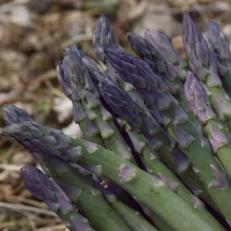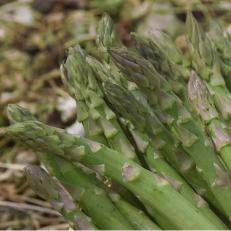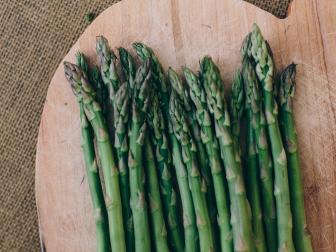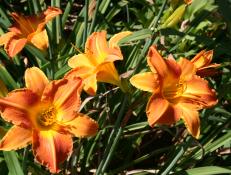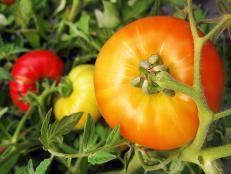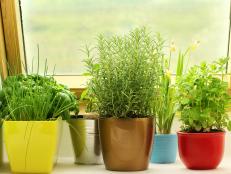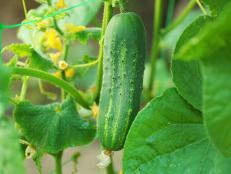How to Grow Asparagus
Learn what's needed to grow asparagus from planting seeds and crowns and get advice on harvesting asparagus.
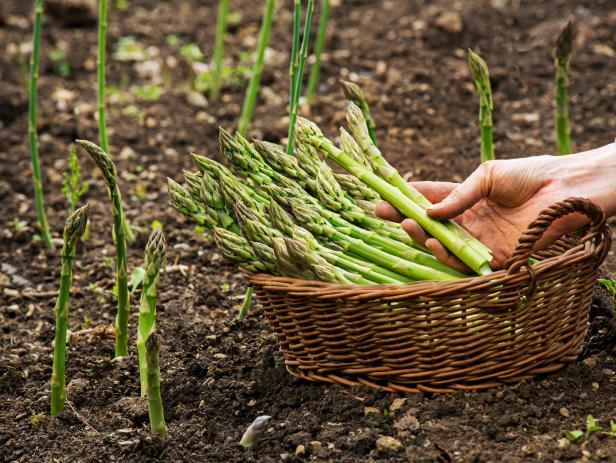
Shutterstock/DUSAN ZIDAR

The tender and flavorful young shoots of asparagus may be one of the first crops to emerge in the spring, but there are usually a few years between planting and the first harvest. While this slow-growing vegetable requires some patience and preparation on the gardener's part, growers are rewarded with decades of harvests of delectable, delicious spears.
The Anatomy of an Asparagus Plant
Asparagus is a long-lived crop that, given the right conditions, will reward gardeners with 15 or more years of bountiful harvests. As a perennial member of the vegetable patch, it's important for gardeners to understand how asparagus grows.
Asparagus produces a "crown" at the base of the plant. This cluster of buds is the growing point where both roots and shoots emerge. The crown will get bigger as asparagus matures and grows, creating wider plants that are dense with vegetation. To ensure your harvest for years to come, always take care to protect the crown.
The young shoots that sprout from the crown are called "spears." These are the tender, edible portions of the asparagus plant. If left unharvested, these spears will develop into fine, feathery foliage known as the "ferns." Asparagus depends on its ferns to harvest energy from the sun that will fuel its current growth and next season's spear development. Gardeners designate a harvest period to collect spears and a growth period where asparagus is able to develop ferns, grow and photosynthesize.
Asparagus are "dioecious," which means they develop male and female flowers on separate plants. Most of the asparagus crowns you'll find at the store are male, and there are a couple of reasons for that. First, male plants don't waste any energy on fruit and seed development, which means they should produce more spears the following season than their female counterparts. Second, when asparagus goes to seed, the offspring can become weedy. In some areas of the country, it can be difficult to manage escaped asparagus seedlings. This is only a problem with female asparagus plants.
Choosing Which Asparagus to Grow
Seeds or Crowns?
Asparagus can be grown from seed or planted as crowns. Regardless of the method you choose, you will need to wait up to three seasons before fully harvesting, but plants grown from seed generally need an extra year to catch up to plants grown from crowns.
While it's common for there to be more varieties available from specialty seed catalogs with most types of vegetable crops, that's not always the case with asparagus. Generally, any varieties available as seed are also for sale as crowns. The biggest difference between growing asparagus from seed and from crowns is that crowns are much more expensive.
Types of Asparagus
While we may be most familiar with standard, grocery-store green asparagus that have spears roughly the size of a pencil, there are more varieties available in different colors and sizes. Gardeners can also choose between hybrid and heirloom types.
Hybrid varieties (like 'Millennium' and the Jersey series from Rutgers University) are valued for their high yields, uniform spear sizes and disease-resistant qualities. Hybrid asparagus plants are typically male, which helps limit unwanted seedlings from popping up in other areas of the garden.
Heirloom varieties (such as 'Conover's Colossal' and 'Mary Washington') may be more susceptible to health problems than their hybrid counterparts, but they make up for their shortcomings by producing crisp, delicious spears. Starting heirloom and other open-pollinated varieties from seed does increase the chances of growing a mix of male and female plants, but you can purchase verified male crowns of heirlooms from specialty growers.
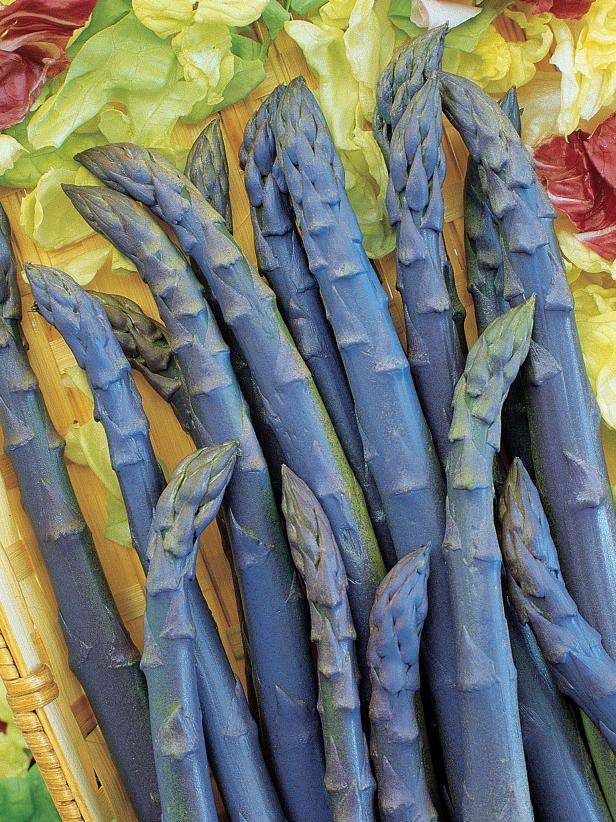
2013, Image courtesy of Burpee Seeds and Plants
Purple Passion Asparagus is sweet and tender.
Purple asparagus (like 'Purple Passion' and 'Sweet Purple') produce stunning violet spears. Purple asparagus tends to have a higher sugar content and even a nutty flavor with a less fibrous texture. The raw spears make a delicious and eye-catching addition to salads, but the unique color will fade when stems are cooked.
White asparagus is actually the result of a process called blanching, where the spears are deprived of light while growing in the garden. However, some varieties take to blanching better than others. Look for the heirloom 'Precoce D'Argenteuil' from specialty seed catalogues.
Buy Asparagus Roots/Crowns
Where to Plant Asparagus
Sunlight, slope and soil are all important when choosing where to grow asparagus. Pick a sunny spot that has at least seven hours of direct sunlight each day. Asparagus is sensitive to cold damage from late frosts in the spring. If possible, choose a spot with northern or eastern exposure, as these sites warm up later than south- or west-facing sites. Good drainage is a must. Asparagus won't be happy in soggy, poorly drained soils.
Asparagus is very sensitive to root disturbance. Choose a spot among other perennial crops — such as strawberries, rhubarb or sunchokes — where the roots won't be disturbed by seasonal cultivation. If you must grow asparagus with annual vegetables, be careful to protect asparagus roots from damage when planting, weeding, harvesting or pulling up spent crops.
Add Organic Matter
Asparagus loves healthy soil, rich in nutritious organic material. Mixing a generous dose of finished compost or fully composted manure into the garden bed before planting will increase the water holding capacity of the soil, improve drainage and feed beneficial organisms.
Do a Soil Test
While it's always a good idea to do a soil test, it's even more important when you're preparing to plant a perennial crop like asparagus. Asparagus prefers lower pH (a measure of acidity and alkalinity) soils close to 6.5, and they can be heavy feeders. A soil test report will include the amount of nutrients, pH level and percentage of organic matter already present in the soil along with tailored recommendations for how to amend your garden bed for healthy, productive asparagus plants. Many state extension service programs offer soil testing for residents.
Planting Asparagus
Starting Asparagus From Seed
Asparagus seeds grow best when soils are between 77 and 86 degrees. If you plan to sow seeds directly in the garden, you can check the soil temperature with a soil thermometer. Plant the seeds between 1/4 and 3/4 of an inch deep in drills. Space rows about 18 inches apart. Thin seedlings to 6 inches apart within rows.
Spread 3 inches of straw mulch over the bed to help suppress weed competition and protect the tender asparagus seedlings. Be gentle while weeding to prevent damaging the delicate young plants. Keep an eye on water as the seedlings become established.
You can also start asparagus seeds indoors 12 to 14 weeks before planting and move them out to the garden after the danger of frost has passed. It takes asparagus seed between three and six weeks to sprout. You can soak seeds in water overnight before planting to speed up germination.
Fill a pot with a standard soilless potting mixture. Scatter several seeds on the surface, then lightly cover with the growing mix. Once the seedlings have emerged, trim out all but the healthiest plant from each pot. Plant outdoors when temperatures are consistently above 60 degrees. Avoid burying the seedlings too deeply.
Do not harvest any seed-grown asparagus for the first two years. Modern hybrid varieties may mature more quickly and can be harvested in the second year. Check the seed packet to learn how your variety should be handled.
Starting Asparagus From Crowns
Growing from one-year-old crowns is the most popular way to grow asparagus. Whereas asparagus seedlings shouldn't be put out until after the last frost, asparagus crowns should be planted between 2 and 4 weeks before the last frost. For this reason, crowns are usually purchased in the spring.
- Soak the crowns in water before planting in the ground. Some sources recommend soaking overnight, while others say that 20 minutes is sufficient.
- Dig a furrow that is a foot wide and between 5 and 12 inches deep, with rows between 3 and 6 feet apart. Make a shallow ridge at the bottom of the furrow. Asparagus should be planted about 5 or 6 inches deep in heavy clay soils and deeper in light sandy soils. Gardeners in cool Northern climates may need to bury crowns deeply in order to insulate plants over the winter. Check with your local extension service to learn the best practices for your region.
- Place the crowns in the furrow, spacing plants about a foot apart. Make sure the buds face up and the roots are spread along the bottom of the furrow.
- Cover the crowns with 2 to 3 inches of soil, leaving the rest of the soil hilled along the side of the furrow. Gently cover with more soil (between 3 and 4 inches at a time) as sturdy stalks emerge over the first growing season. The hilled soil should all be backfilled by the middle of summer. Some growing resources suggest that furrows can be completely filled at planting without damaging the plant.
- Do not harvest any spears during the first growing season.
Growing Asparagus
Water Needs
Tender and succulent asparagus spears are dependent on sufficient water. Make sure plants receive an inch of water per week during the first growing season. After the first year, asparagus needs an inch of water per week during the harvest period and occasional watering during drought. Water the soil rather than the foliage to limit disease.
Fertilize as Needed
Hang on to your soil test report and apply the recommended amount of fertilizer around crowns in the spring before spears emerge and (if needed) in the summer, after you're finished harvesting for the season. Scatter the fertilizer over the soil surface and be careful not to damage any roots. Once the asparagus bed is established, it's a good idea to send out for a new soil test every three years or so for updated guidance.
Spread Mulch
Add a healthy layer of leaf mold, compost or well-rotted manure around (but not directly over) asparagus crowns in the spring before spears appear and in the summer after the harvest period has ended. Mulch will reduce weed growth, hold moisture and moderate soil temperatures. Spreading a thick layer of mulch in the fall can help control crown rot disease by limiting fluctuations in soil temperature over the winter.
Scout for Health Issues
Unfortunately, pests such as asparagus beetles and diseases like asparagus rust and fusarium root and crown rot can cause serious health problems. If you spot red asparagus beetles, pick them off the plant by hand or spray them off with water. Completely remove all the dry, dead ferns at the end of the growing season, as these can harbor pests over the winter. If you suspect your asparagus plants may be diseased, reach out to your local extension service for help diagnosing and remedying the problem.
Asparagus Companion Plants
Companion planting is the practice of combining two different plant partners to maximize the plant health and yields. In her book Plant Partners: Science-Based Companion Planting Strategies for the Vegetable Garden, Jessica Walliser recommends sowing a living mulch of winter rye among asparagus plants at the end of the harvest period in late spring. Winter rye is allelopathic, which means its roots exude chemicals that inhibit seed germination and seedling growth of competing plants without injuring the roots of perennial plants, like asparagus. The foliage of winter rye also protects the soil surface from crusting and erosion. Asparagus grown with a living mulch of winter rye may need more water during the growing season.
How to Harvest Asparagus
When to Harvest Asparagus
Patience is a virtue — especially when it comes to harvesting asparagus. The age and vigor of the plants and environmental conditions all factor in to the duration of the harvest period. Asparagus generally shouldn't be harvested the year it's been planted (up to two years for some seed-grown plants).
Freezing Asparagus
Preserve the garden-fresh flavor of this spring vegetable by stashing spears in the freezer.
Harvest lightly for one week of the year after planting. In the second year, harvest spears for two to three weeks. After the third season, asparagus can be harvested for up to eight weeks, from when spears first emerge until summer solstice (depending on your region). Check the garden frequently during the harvest period. Asparagus spears grow very quickly — up to 2 inches a day! Plan to pick spears at least every other day during cool weather and on a daily basis when it's warm outside.
Pick spears that are between 6 and 10 inches tall. Simply use your hand to grasp the spear and snap it off at ground level. When spears are less than a pencil width in diameter, it's best to stop harvesting and allow the spears to develop into ferny foliage.
How to Divide Asparagus
Unlike other perennials that need to be rejuvenated by division every few years, asparagus will grow happily for more than 15 years without being disturbed. Although asparagus crowns don't usually need to be split to stay productive, dividing is a great way to expand the asparagus patch or share plants with friends.
It's easy to lift and divide plants from an established asparagus bed. The best time to divide asparagus is when it's fully dormant in late winter or early spring. This crop can be fussy and will resent being divided while it's actively growing. It's best to wait if you see any spears or green ferns.
Begin by trimming back any of the dry and brittle fronds from last year. Use a pitchfork to gently lift the roots and crown from the earth. Rinse the soil from the roots, then gingerly separate the crowns. Any woody sections can be discarded at this stage. A healthy crown should have several good buds and plenty of roots. Replant the divisions as soon as possible according to the directions above (see "Starting Asparagus from Crowns").
Asparagus Recipes From Food Network
See these amazing asparagus recipes — from simple, roasted sides to elegant risottos.







